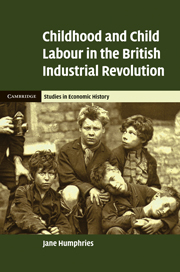11 - Conclusions
Published online by Cambridge University Press: 06 December 2010
Summary
This book has explored more than 600 autobiographies by men who lived through the British industrial revolution and described their labour as children, their childhoods, their family and social connections, their careers and their schooling. It has searched these accounts for patterns and relationships. What has this prosopography revealed?
The autobiographies suggest that the classic era of industrialization, 1790–1850, saw an upsurge in child labour. This finding is consistent with other recent studies, which have reaffirmed the importance of children's work in the industrial revolution. Moreover, the evidence is equally emphatic, and again in line with other recent findings, that child labour was endemic in the early industrial economy, entrenched in both traditional and modern sectors and widespread geographically.
It is hardly surprising that agriculture, small-scale manufacturing, and services should provide the majority of jobs for children. After all (as the new view of the industrial revolution emphasizes), these sectors, along with customary methods of production, dominated the developing economy, with factories and mechanization but tiny islands of modernity until well into the nineteenth century. Ironically, recognition of child labour's importance in traditional employments has coincided with a new appreciation for the role of agriculture, small-scale manufacturing and services in industrialization and so has helped to restore child workers to the centre of the economic stage.
However, child labour was not supplied passively to farms, workshops, domestic enterprises, shops and offices.
- Type
- Chapter
- Information
- Childhood and Child Labour in the British Industrial Revolution , pp. 366 - 373Publisher: Cambridge University PressPrint publication year: 2010

